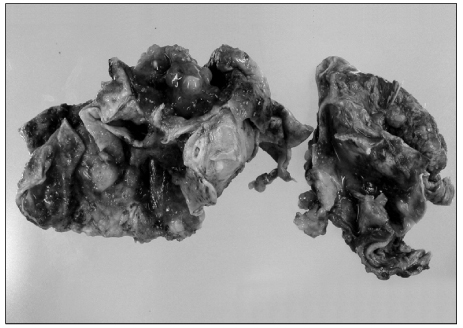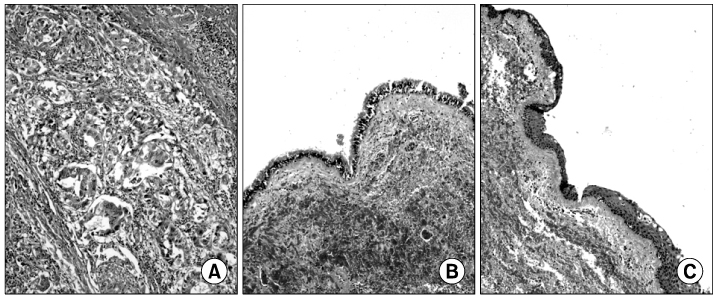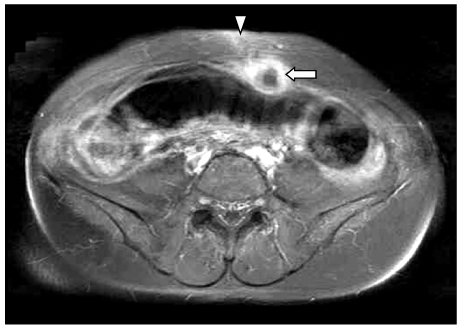J Gynecol Oncol.
2009 Jun;20(2):126-128. 10.3802/jgo.2009.20.2.126.
A case of mucinous adenocarcinoma arising from retroperitoneal teratoma treated with chemoradiation
- Affiliations
-
- 1Department of Obstetrics and Gynecology, School of Medicine, Catholic University of Daegu, Daegu, Korea. drcys@cu.ac.kr
- 2Department of Pathology, School of Medicine, Catholic University of Daegu, Daegu, Korea.
- KMID: 2245097
- DOI: http://doi.org/10.3802/jgo.2009.20.2.126
Abstract
- Retroperitoneal teratoma with malignant transformation is a rare condition in adults. Its most common malignant transformation is into a squamous cell carcinoma, but rarely into a mucinous adenocarcinoma. Postoperative treatment of mucinous adenocarcinoma arising from teratomas has not been established due to its rare incidence. Here we present a case of retroperitoneal mucinous adenocarcinoma arising from a teratoma in the presacral area. Operative and postoperative managements are described with a brief review of the literatures.
MeSH Terms
Figure
Reference
-
1. Templeman CL, Fallat ME, Lam AM, Perlman SE, Hertweck SP, O'Connor DM. Managing mature cystic teratomas of the ovary. Obstet Gynecol Surv. 2000. 55:738–745.2. Gschwend J, Burke TW, Woodward JE, Heller PB. Retroperitoneal teratoma presenting as an abdominal-pelvic mass. Obstet Gynecol. 1987. 70:500–502.3. Renato F, Paolo V, Girolamo M, Vigano L, Alessandro P, Claudio V, et al. Malignant retroperitoneal teratoma: case report and literature review. Acta Urol Belg. 1996. 64:49–54.4. Tezel E, Sare M, Edali N, Oguz M, Uluoglu O, Gokok NH. Retroperitoneal malignant teratoma: a case report. Mater Med Pol. 1995. 27:123–125.5. Chu PY, Teng TH, Lee CC, Chou YY. Adenocarcinomas arising from primary retroperitoneal teratoma in an adult female patient. Int J Urol. 2006. 13:1352–1354.6. Song ES, Choi SJ, Kim L, Choi SK, Ryu JS, Lim MK, et al. Mucinous adenocarcinoma arising from one retroperitoneal mature cystic teratoma in a postmenopausal woman. J Obstet Gynaecol Res. 2005. 31:127–132.7. Wang LJ, Chu SH, Ng KF, Wong YC. Adenocarcinomas arising from primary retroperitoneal mature teratomas: CT and MR imaging. Eur Radiol. 2002. 12:1546–1549.8. Fioretti P, Gadducci A, Ferdeghini M, Bartolini T, Bianchi R, Facchini V. Correlation of CA-125 and CA19-9 serum levels with clinical course and second-look findings in patients with ovarian carcinoma. Gynecol Oncol. 1987. 28:278–283.9. Arora DS, Haldane S. Carcinosarcoma arising in a dermoid cyst of the ovary. J Clin Pathol. 1996. 49:519–521.10. Ozols RF. Paclitaxel (Taxol)/carboplatin combination chemotherapy in the treatment of advanced ovarian cancer. Semin Oncol. 2000. 27(3):Suppl 7. 3–7.11. Franciolini G, Momoli G, Minelli L, Mutolo F, Franchini MA, Chiodini S, et al. Cutaneous metastases from carcinoma of the cervix. Tumori. 1990. 76:410–412.12. Lane G, Tay J. Port-site metastasis following laparoscopic lymphadenectomy for adenosquamous carcinoma of the cervix. Gynecol Oncol. 1999. 74:130–133.
- Full Text Links
- Actions
-
Cited
- CITED
-
- Close
- Share
- Similar articles
-
- A Case of Carcinoid Tumor and Low Grade Mucinous Adenocarcinoma Arising in Ovarian Mature Cystic Teratoma
- An ovarian mucinous cystadenocarcinoma arising from mature cystic teratoma with para-aortic lymph node metastasis: a case report
- A Case of Intestinal Type Mucinous Adenocarcinoma and Strumal Carcinoid Tumor arising in One of Bilateral Mature Cystic Teratoma of the Ovary
- A Case of Mucinous Cystadenocarcinoma Arising from a Mature Cystic Teratoma in the Right Ovary
- A Case of Retroperitoneal Teratoma





